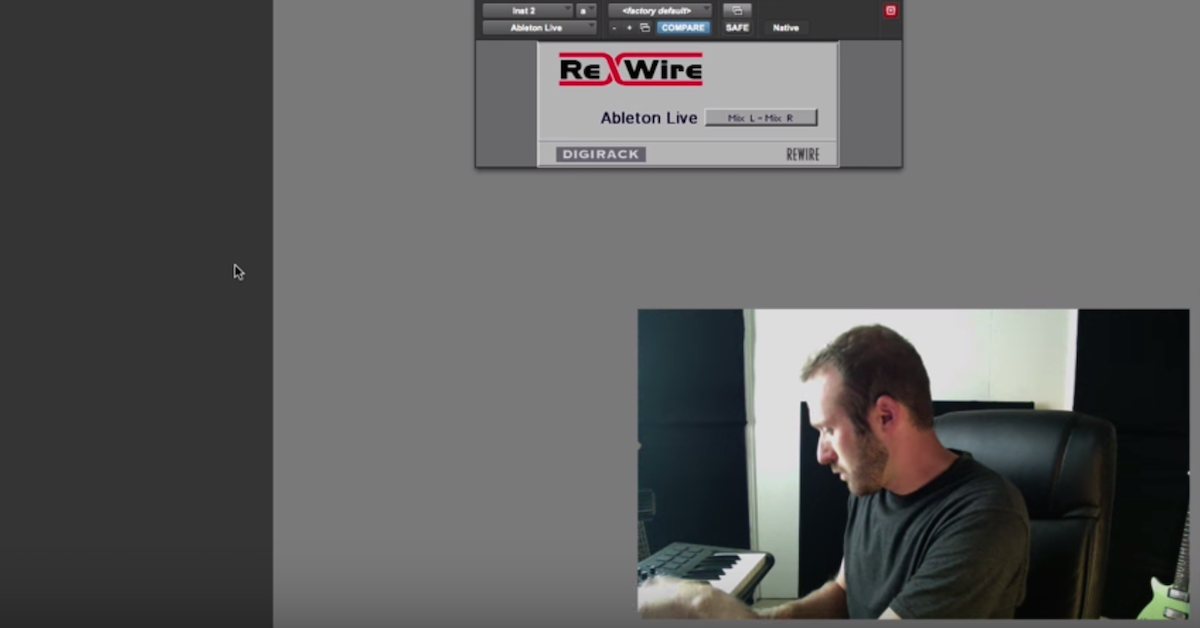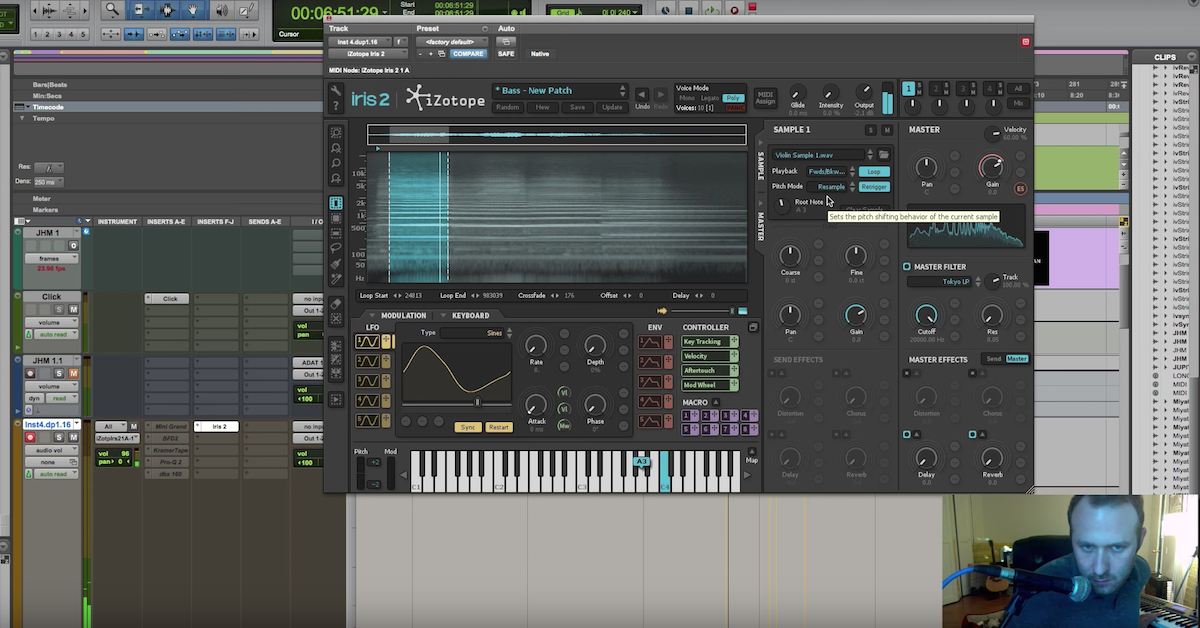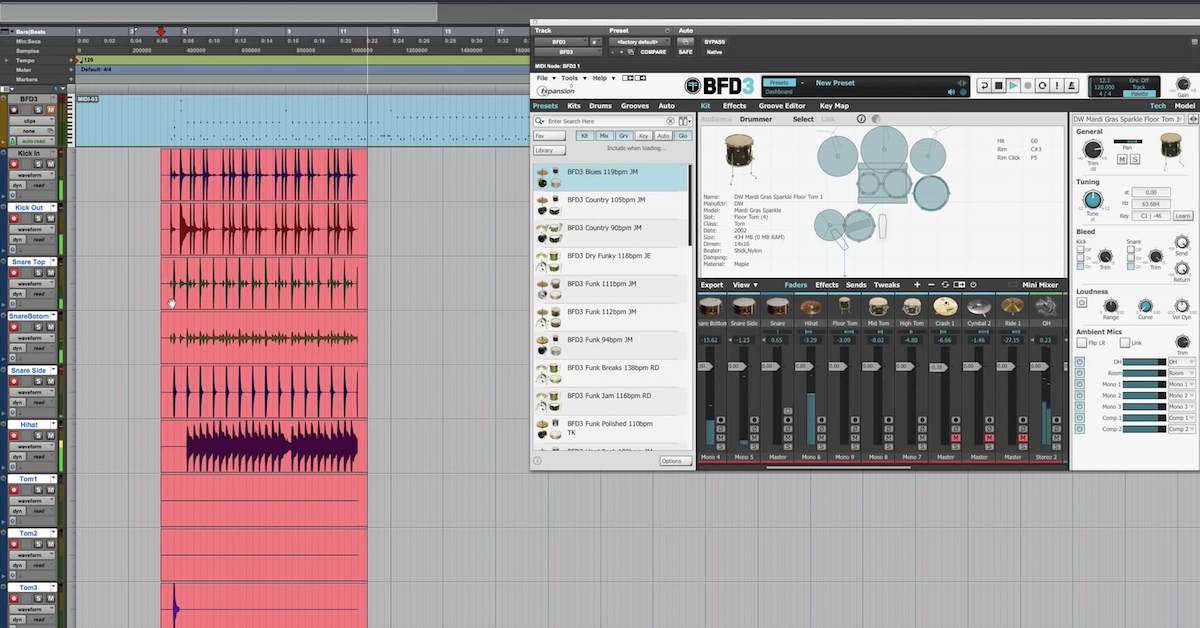The Basics of Generative Music (+ DAWs, Plugins & More)
Article Content
In the beginning, music was a purely live and purely acoustic phenomenon. If you weren’t within earshot of a live musical event, then there was no music for you. This simple musical situation — which seems so primitive to us today — was how human beings experienced music for something like 99.98% of the history of our species. I, for one, appreciate living in this era of advanced music technology which provides us with plentiful and easily obtained musical experiences. Still, live music is wonderful because of its potential for spontaneity and its unpredictability — anything can happen in a live concert and no two live musical performances will ever sound exactly alike.
The 1887 invention of a sound recording and playback device was, of course, a major development. Now sound could be captured, stored and reproduced later in a totally different environment. Now you could have sound that was captured in a concert hall, for example, played in your living room. For many years, sound recordings were strictly a real-time documentation of the sounds made during the recording process. This would all change with Les Paul’s revolutionary inventions of sound-on-sound overdubbing and then later (and more importantly) with multitrack recording, which is still the standard system for producing recorded music today. These inventions meant that recordings could be something designed from the ground up at the musician’s leisure rather than simply documented in real time. Crucially, recorded music has always resulted in a static sound product that was unchanging from one playback to the next (the deterioration effects of analog mediums aside). A traditional static musical recording can only be played so many times before all of its mysteries are revealed to the listener.
With generative music, there’s now a third paradigm for musical expression. Generative music shares characteristics with both live and recorded music. Like live music, generative compositions will never sound exactly the same from playback to playback — each is unique due to some sort of randomizing process or processes. Like recorded music, generative music is not exclusive to a specific time and place.
Nowadays, generative music is usually created and played back on some sort of computing device due to a computer’s ability to generate and randomize musical events. These generative compositions often take the form of computer applications when they’re published — in this case the compositions consist of musical elements that are driven by software. It’s a fascinating synergy of creativity and technology. A prominent practitioner of this form is pioneering composer Brian Eno, who has released numerous generative compositions including 1996’s historic Generative Music 1 — released as a floppy disk. While that particular composition would require some specific antiquated technology to play back properly today, there are also a series of Eno’s modern generative compositions in the form of iOS apps that can be experienced right now on most iOS devices.
In this article, I’ll briefly introduce some of the concepts behind generative music, and I’ll offer some recommendations for software tools that you can work with to produce generative compositions yourself.
What is Generative Music?
With traditional compositions, musical events are planned out in advance, and then performers will typically rehearse these events in an effort to execute them as precisely as possible. In generative composition, rather than composers concerning themselves with the minutiae of the moment to moment musical events, they’ll instead endeavor to design systems that will generate music according to the instructions and parameters they specify in their generative design. This music could be generated by live performers adhering to a designed generative system, software tools that implement generative techniques or even according to random or semi-random environmental phenomena (e.g. wind chimes).
This sort of musical thinking can be traced back to American composer John Cage. In the early 1950s, Cage developed what he called “indeterminacy,” where certain elements of a musical composition were left to chance. For example, a musical event might lead to one of two possible outcomes — this might be decided with a coin toss. Perhaps there could be six possible pathways that could be determined by the toss of a die. After Cage developed these chance-based composition techniques, they were immediately adopted and further developed by a wide range of composers — but it was Brian Eno who brought chance and generative music into the digital age when he published generative music created with the groundbreaking SSEYO Koan generative composition software (now known as Wotja, see below) in 1996.
So what is the appeal of generative music? Well, appeal is a very subjective thing and generative music is currently well outside of the cultural mainstream and practiced by a relative few. But to me, it comes down to the way it can balance unpredictability with musical identity. It’s also a new and mostly unexplored form of musical expression. What’s not to love? Skilled composers of generative music are capable of creating easily identifiable compositions with a strong sonic identity — but each time the composition is played, the specific sequence of musical events will vary in some way. This keeps things from getting stale as quickly as a static recording would, and it can provide genuinely exciting and beautifully unexpected musical moments with the right approach.
An example: here’s a long-form generative composition I made myself and released on Heart Dance Records. In this situation, the generative tool used was Ableton Live’s Follow Actions, which allow for (among other things) a weighted chance operation to determine the playback order of a group of pre-prepared clips.
(Link to other streaming services)
Generative Composition Tools
Unless you’re handy with coding, the specific techniques deployed in generative compositions are going to be at least somewhat dictated by the tools used, because each commercially-available tool provides a specific collection of techniques that can be deployed in a composition. As you’ll see, there’s quite a bit of overlap between the tools listed here, but several offer genuinely unique and innovative interfaces, generative techniques and overall approaches to generative composition. Of course, multiple tools can usually be used side by side in a project to expand your collection of design tools.
The tools listed here are divided into DAWs (and DAW-like applications) that offer generative tools, and then plugins that work within a DAW — typically by generating MIDI instructions to be used in your DAW or external hardware.
DAWs and Generative Composition Apps
Some standard DAWs offer enough built-in tools for a serious generative music production, while other apps listed here are specifically designed with generative composition as the sole purpose. For this list, I’ll be defining a DAW as a software application (not a plugin) that provides a generative composition environment. Some offer an excellent internal collection of instruments and effects, and some can host third-party plugins. Sometimes you may want to consider using a certain application’s MIDI output (rather than the application’s audio output) and then route that MIDI data to another DAW or to external hardware, so that you can access other preferred timbres and production tools.
Wotja by Intermorphic
The beginnings of Wotja date back all the way to 1986, so this generative music creation software has benefitted from a long developmental period and is therefore the generative app that offers the most to explore. The generative design system and structure of the software allow for much experimentation and supports a wide range of generative production techniques. Seriously, this software package can do it all. There’s a standalone app that provides built-in software instruments and effects, plus it’s capable of hosting third party plugins. Wotja can also operate as a plugin inside your favorite DAW, sending generative MIDI to the instruments and effects of your choice.
The software has undergone several rebranding efforts over the years. If you ever see product names like Koan by SSEO or Noatikl by Intermorphic, you can assume that the technology being referenced is close in function to Wotja, albeit in an earlier form.
For a serious practitioner of generative music today, Wotja is an attractive, deep, expressive and flexible offering. Wotja almost certainly supports the device of your choice — it offers support for iOS, macOS, Windows, Android, tvOS and watchOS. Like any advanced music production software tool, Wotja has a substantial learning curve for the new user to tackle. Get ready to read the manual if you want to take full advantage of this powerful tool.
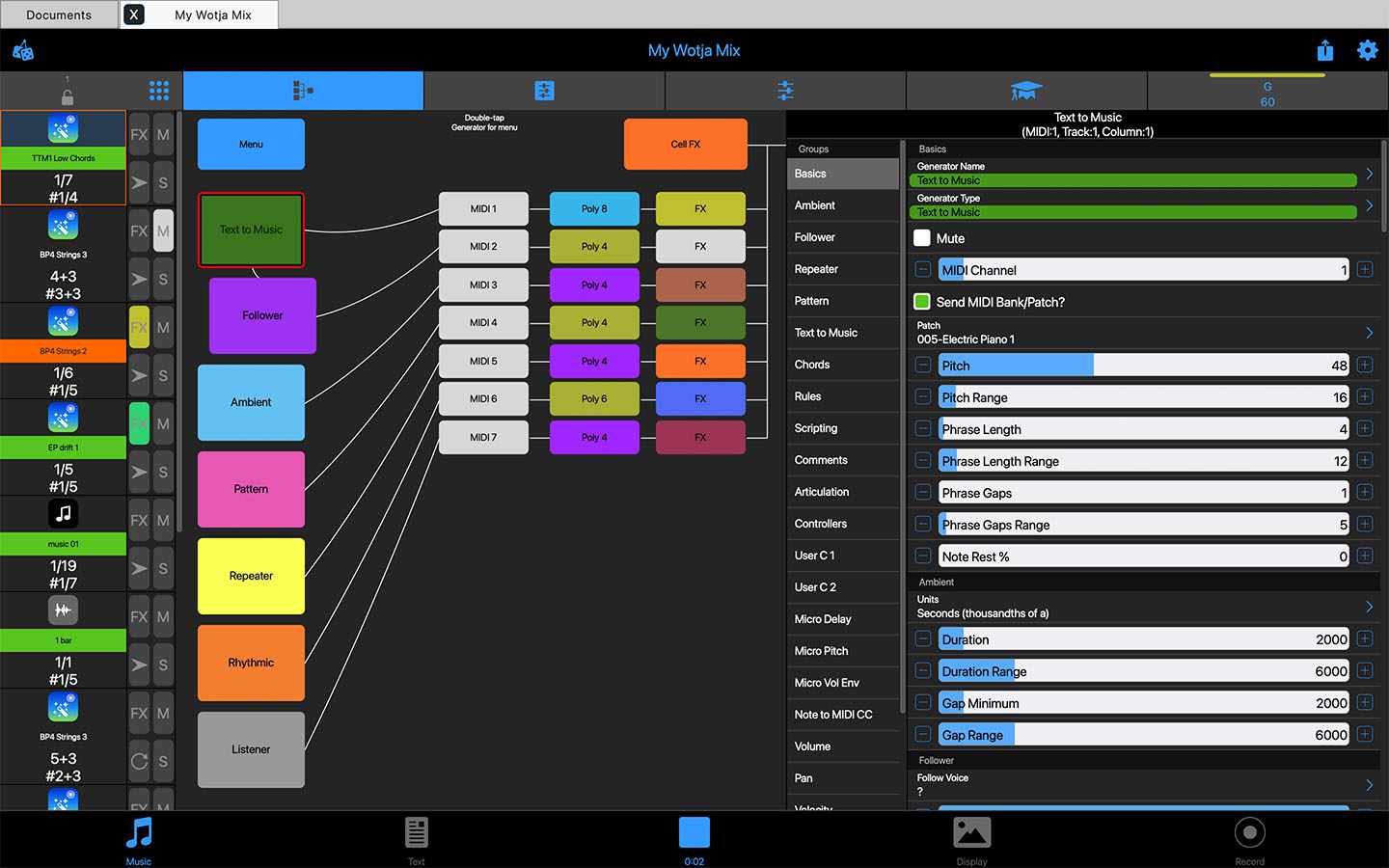
Nodal
Nodal is a relatively recent addition to the generative software market, currently being sold as version 2.0. Nodal offers a simple yet expressive set of generative tools, and is quite distinct from other offerings. The user is presented with a two-dimensional grid, and on this grid “nodes” are placed and connected together. There’s a lot of power in these nodes; each one can store note and velocity information, along with an assigned probability that each pitch will sound. Nodes can then be routed to other nodes in a variety of ways — the potential to create complex networks of looping and non-looping nodal structures is exciting and intuitive.
While Nodal does include a simple software instrument, any project undertaken with Nodal that requires substantial sound design work will likely require Nodal’s MIDI output to be routed into your DAW or to your MIDI-capable hardware instruments. The included instrument is functional but isn’t really intended to compete with purpose-built hardware or software instruments.
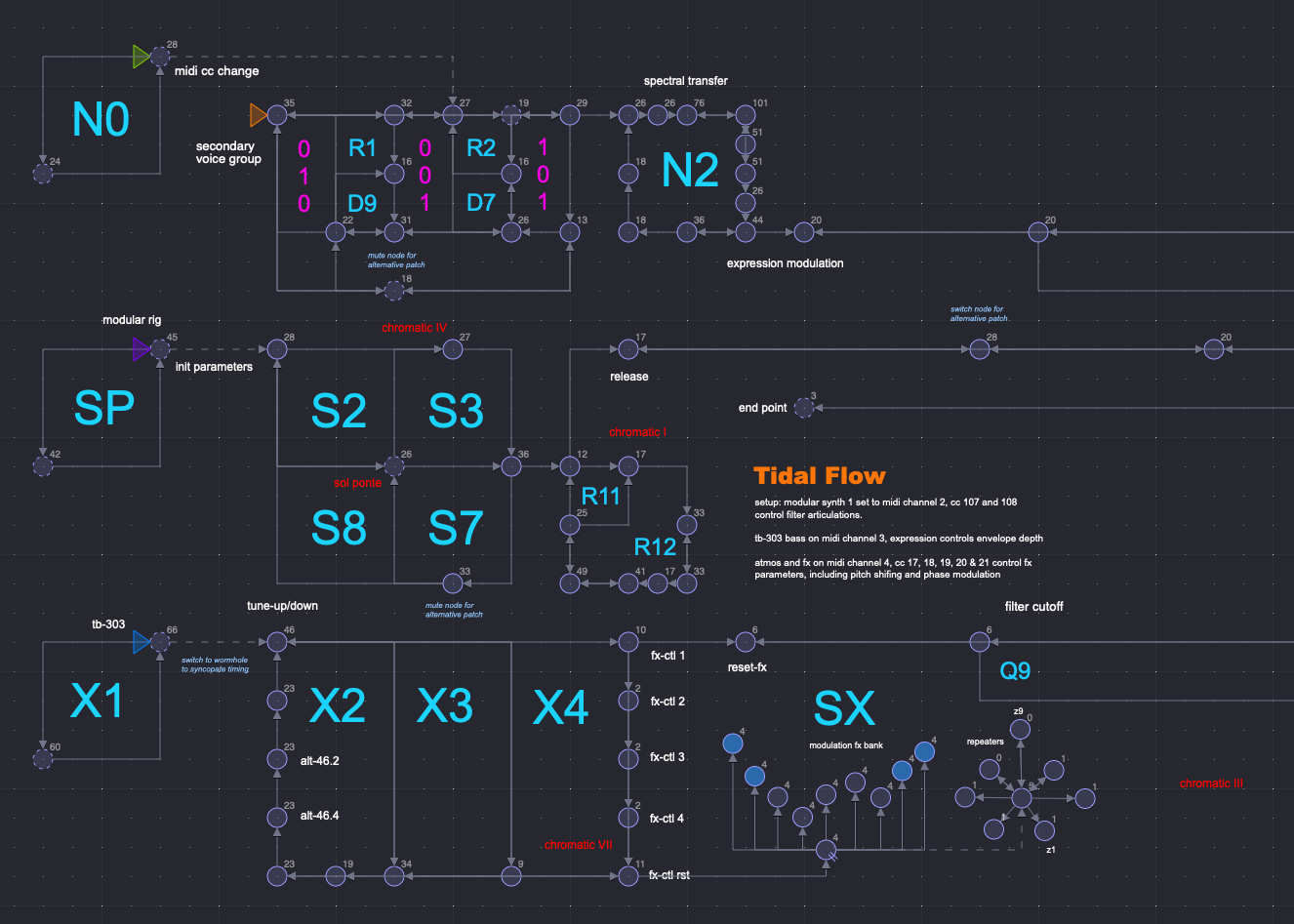
Ableton Live
Of all of the standard workaday DAWs out there that are primarily designed for more traditional music production tasks, none offer the breadth and depth of generative tools that Ableton Live offers. This is especially true when the generative tools developed with the Max for Live visual programming environment, bundled in the Suite Edition, are taken into account. There are a whole host of devices in Live that can be used for generative compositions. Here’s an incomplete list:
- There are several built-in MIDI effects that can randomize MIDI data values, including pitch, velocity and note duration. Chains of these devices, in both serial and parallel configurations, can be built using Ableton’s MIDI Effect Racks to create rich generative systems.
- In the piano roll editor, every MIDI note can have a probability assigned to it that will determine if the note will sound or not.
- Ableton’s Session View includes “Follow Actions.” These can be set up to randomize the playback order of clips on a particular track. I created an album of generative ambient music that made use of this technique. I composed a few dozen clips in the session view which were spread across 25 tracks, and then randomized the playback order of those clips via the follow actions.
- The stock LFO device can be used to modulate nearly any parameter in Live. It includes a random wave shape (among others), so this device can be used to randomize all kinds of things including an instrument’s timbre, a key parameter on an audio effect or an impactful knob or button on a MIDI effect.
There’s also a growing collection of generative Max for Live devices that have been developed by third-parties. These devices can be deployed in an Ableton set just like the stock MIDI effects, audio effects and instruments. Here’s another incomplete list:
- Kaigen by Jeff Kaiser — This is a suite of five generative devices, each with its own focus and set of generators. The Kaigen-M2 device, for example, generates single musical lines potentially with harmonic additions — great for bass lines and melodic material. Pitches, rhythms, velocities and note durations can be randomized within specific ranges of values. This is a deep and powerful set of generative tools.
- Inspired by Nature by Dillon Bastan — Here’s a collection of devices that model natural forces like bouncing balls, plant growth and the physical movement of particles. These phenomena can then be used to modulate a wide variety of parameters in Live.
- Melodic Steps by Ableton — This device is a 16-step MIDI sequencer capable of randomizing pitch, note duration and velocity. It also includes the ability to assign a probability to each step that the note will sound or not. With a WYSIWYG user interface, this is one of the easiest generative devices to get started with while still offering a lot of creative potential.
- Probability Pack by Sonic Faction — This pack provides five devices with randomizing features including three step sequencers, an arpeggiator and a device titled “Dr. Chaos,” which Sonic Faction describes as “a neural network that strings together notes and generates melodies in unpredictable ways.”
- Tricky Traps by Sonic Faction — There are 16 devices in this pack, and each provides a unique twist on more traditional instruments, MIDI effects and audio effects. If you’re a user of Ableton’s Push instrument, this pack is especially worth checking out — each of the devices have been custom mapped to Push.
- MIDIvolve by Coldcut — An arpeggiator, riff generator and sequencer in one device, MIDIvolve “automatically ‘evolves’ live or imported MIDI patterns into new riffs, melodies and grooves.”
- Patter by Adam Florin — Patter includes some features that aren’t usually found on generative devices, including a looping function, phrasing controls, and it includes the ability to communicate with other Patter devices within a Live set.
- Auto-Beat by K-Devices — While this percussion-specific device will generate drum ideas for any MIDI percussion instrument, Auto-Beat has excellent integration with Ableton’s Drum Rack. Each of its eight steps within the included sequencer are capable of randomizing note-on chance and velocity. Each drum lane can be edited to have its own time resolution setting — including triplets and dotted notes. Additionally, each drum sound can have a custom number of steps on the sequencer — great for setting up polyrhythmic parts.
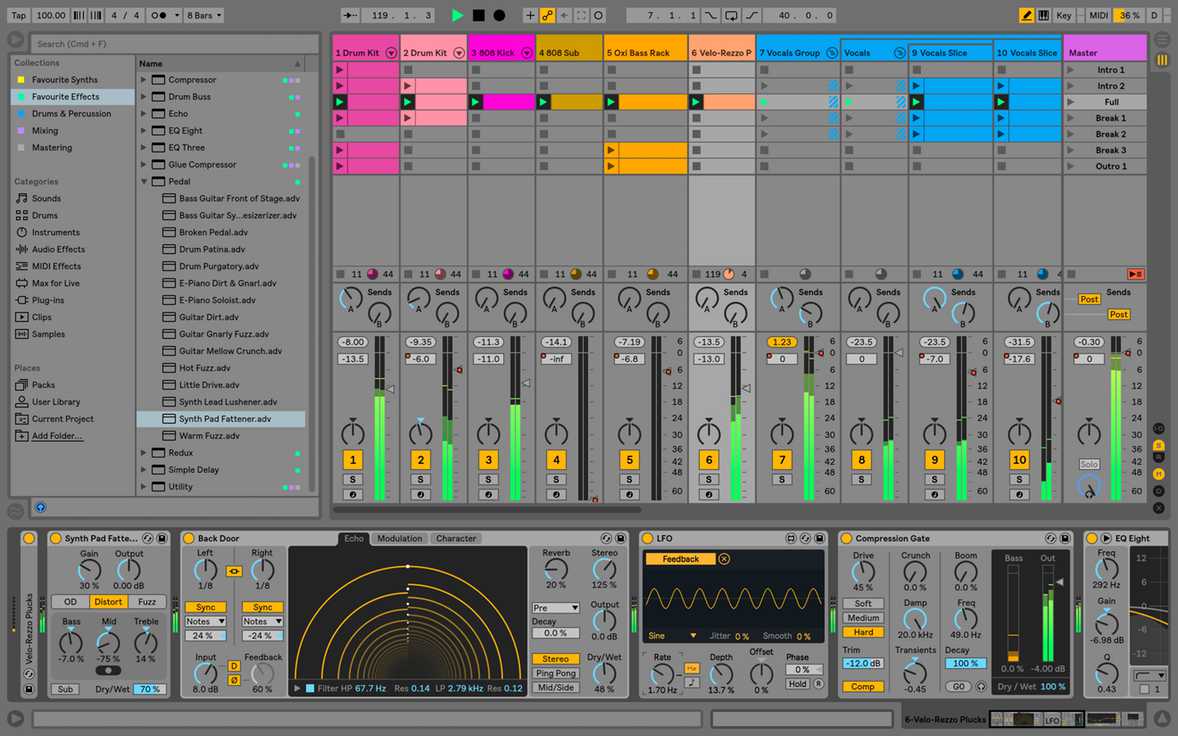
Bitwig Studio
As a longtime Ableton Live user, Bitwig has been on my radar for quite a while now — but I never did take this newcomer DAW for a test drive until I began preparing to write this article. Bitwig was created by former Ableton developers, and it shows — there’s more than a passing resemblance between the two DAWs. When it comes to the differences between the two, many can be considered a win for Bitwig, but not all. For example, Bitwig features plugin sandboxing — a technology that prevents Bitwig from crashing if a third party plugin crashes. I can’t tell you how many times I’ve had large Live-based projects utilizing dozens of plugins grind to a halt because of one badly behaved plugin. Whenever this happens in Live, an excruciatingly slow and tedious troubleshooting process is required to get back up and running. In Bitwig, when a plugin crashes, your project doesn’t — you can just reload or swap out the plugin that crashed. Amazing! That being said, as a newer DAW Bitwig can’t really compete when it comes to the included instruments and effects — Ableton has had well over two decades now to develop an outstanding collection of these devices. Bitwig’s included devices are strong, but the quantity isn’t close to what Ableton provides.
When it comes to producing generative music, Bitwig is competitive but distinct. Like Ableton Live, it includes several useful MIDI effects with generative capabilities, follow actions (called “next action” in Bitwig), the ability to assign a probability that a note will trigger, and Bitwig’s modern, comprehensive and flexible modulation system contains plenty of randomization options too. The Live ecosystem offers Max for Live, a visual programming environment that has been used to develop many generative tools (see above). Bitwig doesn’t offer anything quite like Max for Live — but it does offer its own device-building environment in The Grid. Here there is a large library of modules that can be connected together to create custom instruments, audio effects and MIDI effects. There are several modules that can be used to add generative capabilities to your custom-built devices. The Grid reminds me quite a bit of Reaktor, the device creation software from Native Instruments.
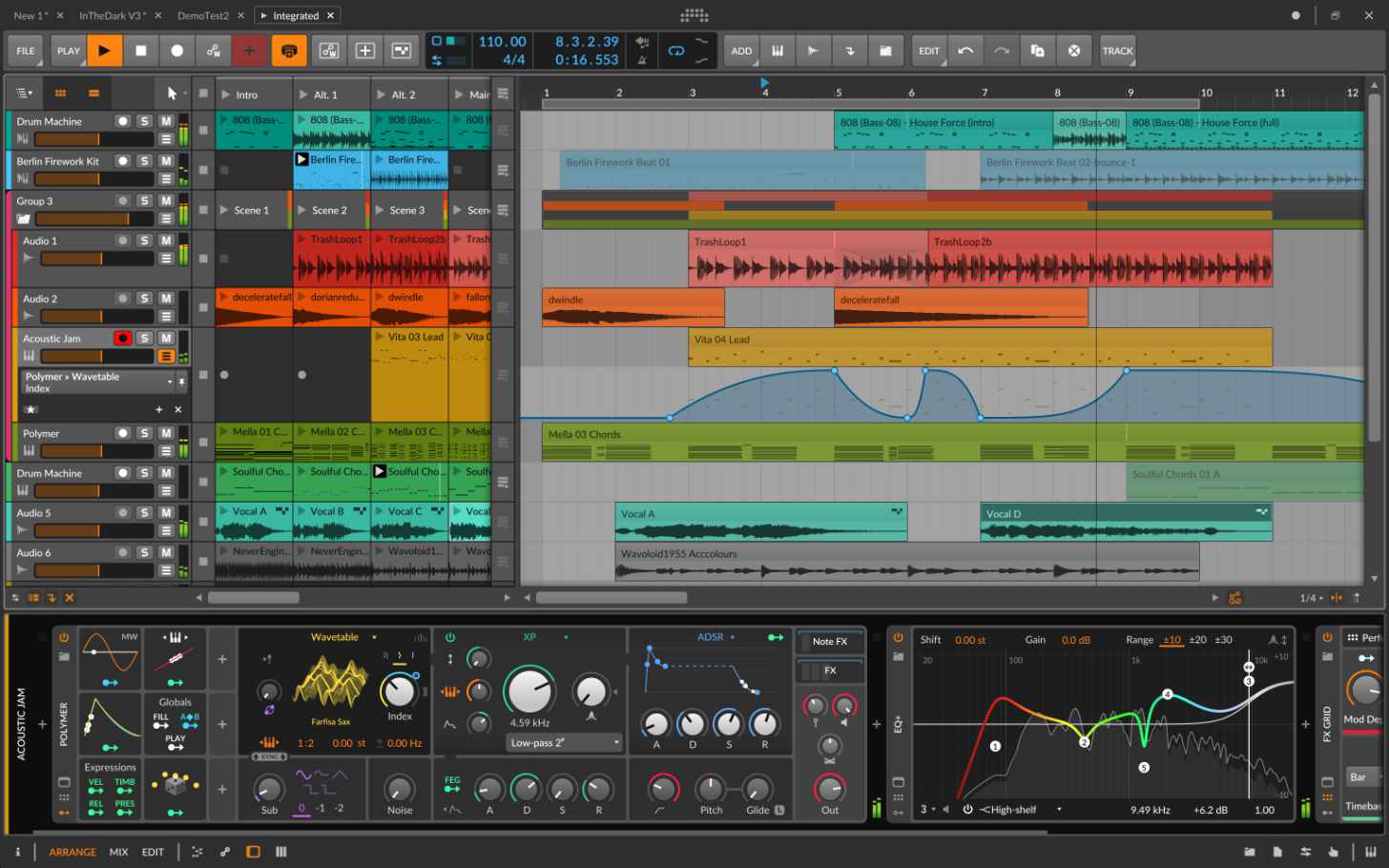
Logic by Apple
Logic, too, includes several generative MIDI effects, plus there’s the powerful Scripter plugin, a tool that offers users the ability to apply their own custom MIDI scripts or to choose from a series of useful, already-scripted presets.
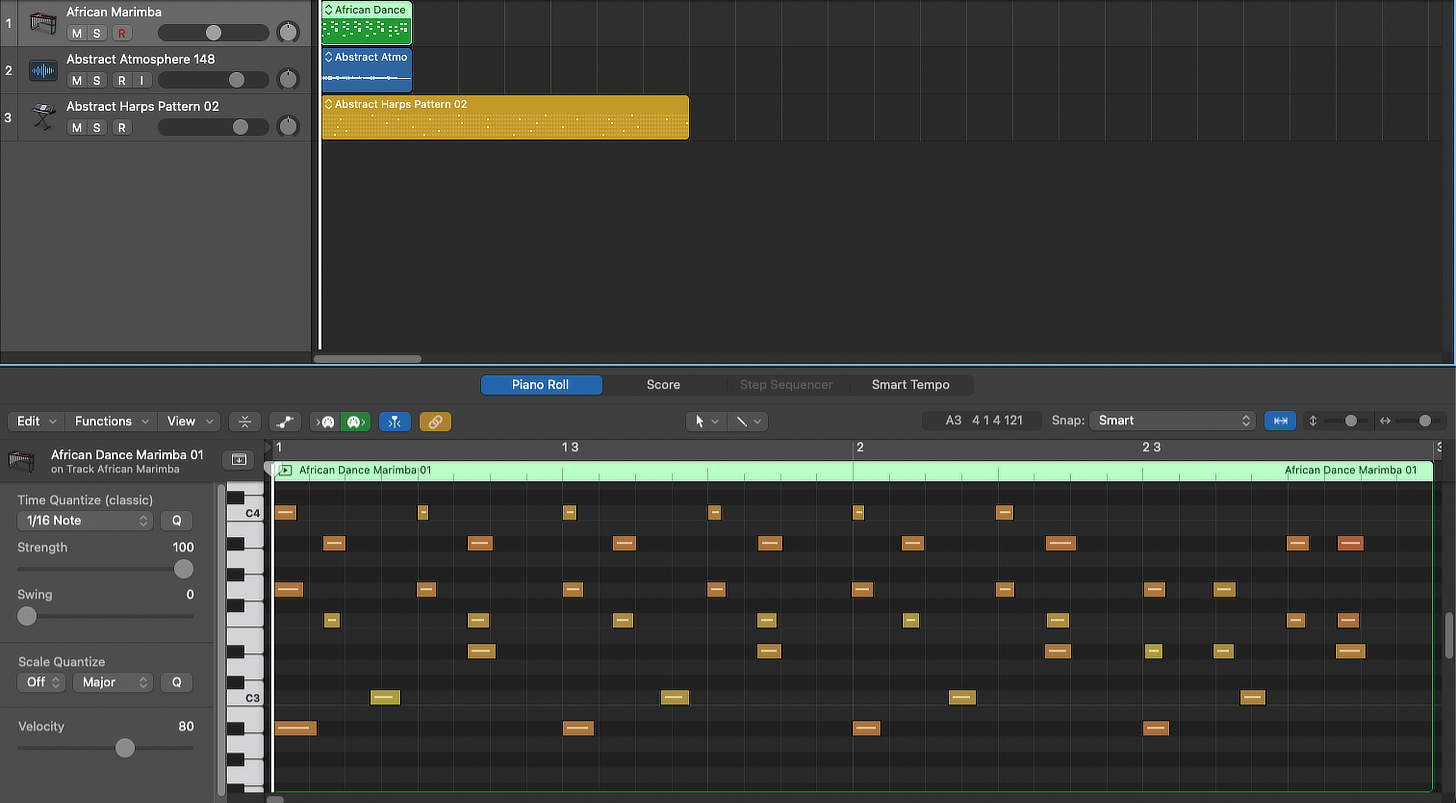
Plugins
If you’re an experienced DAW user, and the idea of learning an entirely new piece of production software doesn’t appeal to you, there are some excellent third-party plugins that can be deployed inside the DAW of your choice. These plugins will generate MIDI messages that can be used for generative composition, and they can work right alongside the existing toolset that you’re already using inside your DAW.
Chordjam by Audiomodern
Note that this plugin’s capabilities most definitely extend far beyond generative techniques — but the randomization options this plugin provides are deep and targeted right at creating generative chord progressions. As a harmony-focused plugin, and an excellent one at that, users will be able to generate, randomize, apply MIDI data filters, transpose, sequence and perform chord progressions. There is a lot to explore here and Chordjam offers a toolset that would likely appeal to both experienced practitioners of chord progressions and those who are new — this plugin could hold a lot of value for less experienced musicians wishing to learn more about Western harmony.
One way to use Chordjam would be to have it play random chord progressions within a series of constraints applied by the user, and then simply sit back and listen for chord progressions to use in your production. In this situation there’s no need to go to the effort of imagining and working out a harmony part — just listen and wait. It’s discovery, not conception.
Audiomodern has really gone out of their way to earn their asking price for Chordjam. This is an interesting, useful and polished product, and the user interface is a thing of beauty — both functionally and aesthetically.

Tatat by K-Devices
Tatat is probably the simplest tool on this list; its user interface is definitely the most straightforward. It’s completely purpose-built for generative music production. The single-window interface contains several sections, each with its own ability to provide the user with a range of generative parameters and the ability to randomize those parameters according to probabilities set by the user. For example, users can generate MIDI that makes use of up to four pitches and three time values (each with probabilities assigned), and those pitches and time values will be played as soon as your DAW’s transport begins playback. Pitches can have an additional note added (selected from a pair of possibilities) to create dyads on the fly. There’s also the ability to randomize note velocity and duration, and users can even set up a MIDI delay that’s also capable of being randomized.
While I admire this plugin for its ease of use and simplicity, I think it’s important to make note of its limitations. For example, users are limited to generating only four different pitches and three time values. When creating harmonies, users are limited to only two simultaneous notes, and those notes can only be selected from two different intervals. I think the layout and functionality that this plugin offers are excellent, but to use this software to make the generative music that I’m personally after, I’d be forced to run extra instances of the plugin to get the functionality I need. But if you’re new to generative music and looking for something that’s easy to get started with, Tatat just might be exactly what you’re looking for.
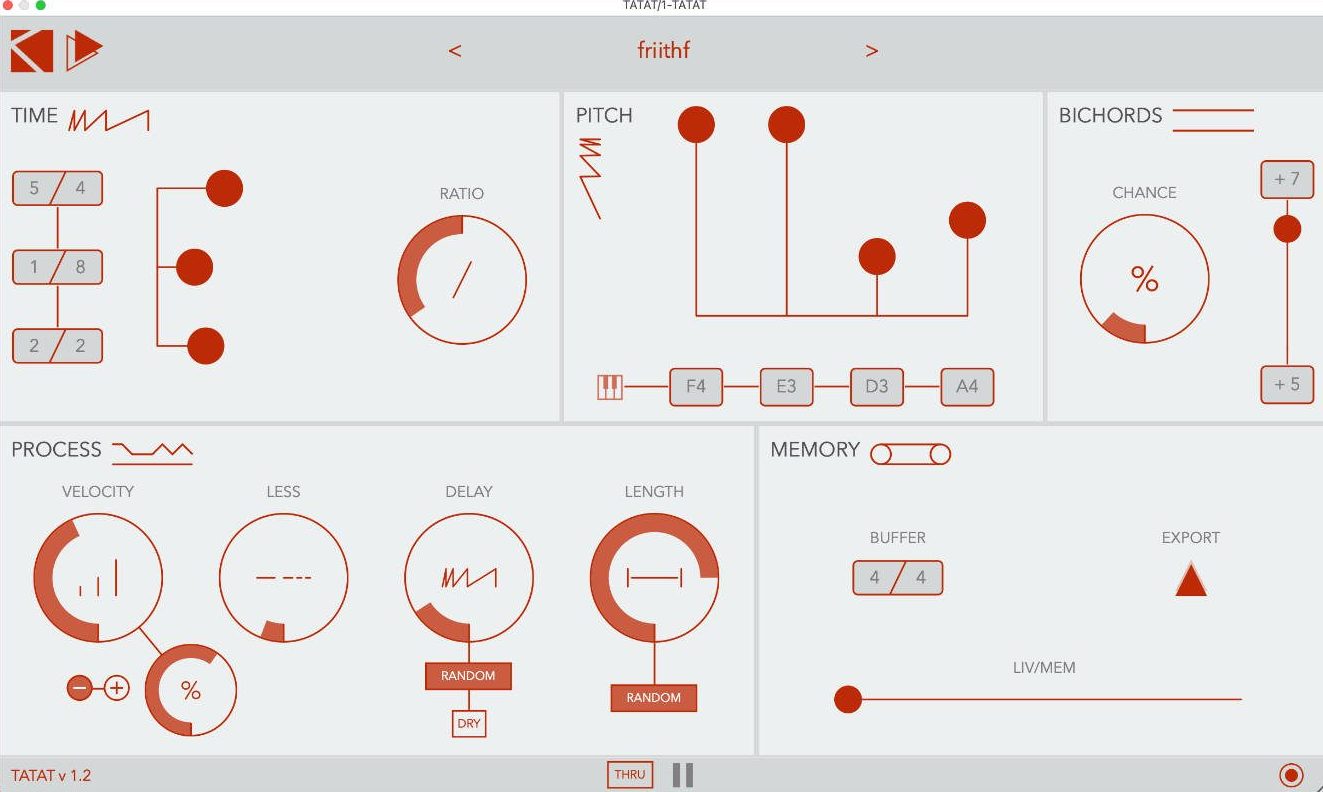
Conclusion
Producing generative music requires a creative method totally distinct from traditional music composition. Whether you’re a seasoned professional composer or just starting out, I’d be willing to wager that exploring this relatively new and exciting form of musical expression would be worth the effort — and may just unlock a creative mode within you that’s yet to be discovered.




